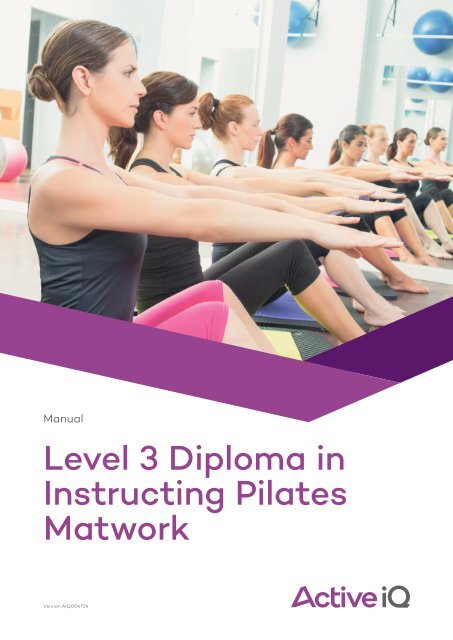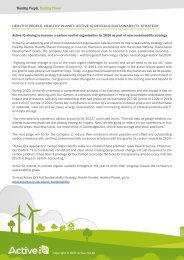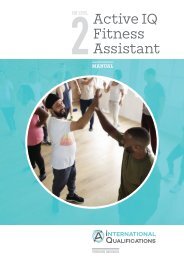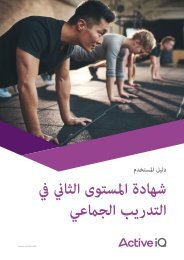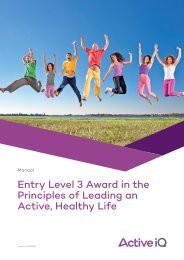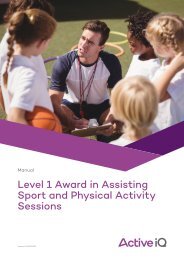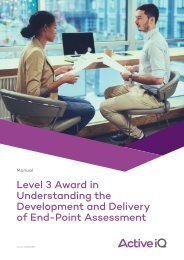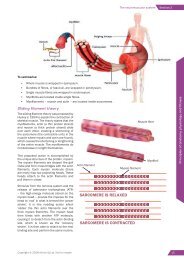Active IQ Level 3 Diploma in Instructing Pilates Matwork (sample manual)
For more information, please visit http://www.activeiq.co.uk/qualifications/level-3/active-iq-level-3-diploma-in-instructing-pilates-matwork
For more information, please visit http://www.activeiq.co.uk/qualifications/level-3/active-iq-level-3-diploma-in-instructing-pilates-matwork
You also want an ePaper? Increase the reach of your titles
YUMPU automatically turns print PDFs into web optimized ePapers that Google loves.
Manual<br />
<strong>Level</strong> 3 <strong>Diploma</strong> <strong>in</strong><br />
Instruct<strong>in</strong>g <strong>Pilates</strong><br />
<strong>Matwork</strong><br />
Version A<strong>IQ</strong>004724
Section 1: The heart and circulatory system and its relation to exercise and health<br />
The valves of the heart<br />
In order to function effectively as a pump, the heart needs<br />
to direct blood through the atria, ventricles and then the<br />
arteries of the body. The heart prevents unwanted backflow<br />
of blood <strong>in</strong>to the chambers us<strong>in</strong>g a number of valves.<br />
These valves open and close <strong>in</strong> response to changes <strong>in</strong><br />
pressure as the heart contracts and relaxes. The structure<br />
of the valves means that they only allow blood to flow<br />
<strong>in</strong> one direction by shutt<strong>in</strong>g once blood has been pushed<br />
through them. This is fundamental to effective circulation;<br />
any back-flow through the heart will compromise the<br />
efficiency of each heartbeat, which is likely to affect<br />
exercise performance and health.<br />
The ma<strong>in</strong> valves of the heart are the atrioventricular (AV)<br />
valves and the semilunar (SL) valves. The AV valves are<br />
located between the atria and the ventricles and prevent<br />
the back-flow of blood from the ventricles <strong>in</strong>to the atria.<br />
As the ventricles contract, pressure rises and forces the AV<br />
valves to snap shut, allow<strong>in</strong>g blood to be directed through<br />
the arteries leav<strong>in</strong>g the heart (pulmonary artery and aorta).<br />
SOMETHING EXTRA<br />
As the AV valves snap<br />
shut, they are anchored<br />
<strong>in</strong> place by tendonlike<br />
chords (chordae<br />
tend<strong>in</strong>eae) which prevent<br />
the valve flaps from be<strong>in</strong>g<br />
pushed too far <strong>in</strong>to the<br />
atria.<br />
The SL valves are located at<br />
the base of the arteries leav<strong>in</strong>g<br />
the heart (aorta and pulmonary<br />
artery). After each contraction,<br />
there is a relative drop <strong>in</strong><br />
pressure with<strong>in</strong> the ventricles<br />
as they relax. At this po<strong>in</strong>t, the<br />
blood with<strong>in</strong> the pulmonary<br />
artery and aorta could potentially<br />
flow back <strong>in</strong>to the ventricles. To<br />
prevent this, both sets of arteries<br />
have SL valves positioned at the<br />
po<strong>in</strong>t where they emerge from the ventricles. As the blood<br />
moves back towards the ventricles, the SL valves snap<br />
shut so blood cannot re-enter.<br />
It is the sequential shutt<strong>in</strong>g of the valves dur<strong>in</strong>g the cardiac<br />
cycle that causes the dist<strong>in</strong>ct ‘lub-dub’ noises associated<br />
with the heartbeat.<br />
Superior<br />
vena<br />
cava<br />
Right<br />
pulmonary<br />
ve<strong>in</strong>s<br />
Right<br />
atrium<br />
Right<br />
ventricle<br />
Inferior<br />
vena cava<br />
Atrioventricular (AV)<br />
valves<br />
Aorta<br />
Pulmonary<br />
artery<br />
Figure 1.2 The heart<br />
Figure 1.3 The valves of<br />
the heart<br />
Left<br />
pulmonary<br />
ve<strong>in</strong>s<br />
Left<br />
atrium<br />
Left<br />
ventricle<br />
Semilunar<br />
(SL) valves<br />
MEMORY JOGGER – HEART CIRCULATION<br />
The heart is stimulated to contract by a complex series of <strong>in</strong>tegrated systems. The heart’s pacemaker –<br />
the s<strong>in</strong>oatrial (SA) node – <strong>in</strong>itiates the cardiac muscle contraction. The SA node is located <strong>in</strong> the wall of<br />
the right atrium. The myocardium (heart muscle) is stimulated to contract about 72 times per m<strong>in</strong>ute<br />
by the SA node as part of the autonomic nervous system.<br />
5 | Copyright © 2017 <strong>Active</strong> <strong>IQ</strong> Ltd. Not for resale
Section 1: The heart and circulatory system and its relation to exercise and health<br />
Short-term effects of exercise on blood pressure<br />
A short-term effect of exercise is a l<strong>in</strong>ear <strong>in</strong>crease <strong>in</strong> systolic blood pressure (SBP)<br />
with <strong>in</strong>creas<strong>in</strong>g levels of exertion. In contrast, diastolic blood pressure (DBP) may<br />
decrease slightly dur<strong>in</strong>g exertion due to vasodilation, or it will rema<strong>in</strong> unchanged.<br />
Individuals with hypertension may experience a rise <strong>in</strong> DBP as a result of an<br />
impaired vasodilatory response.<br />
Heavy weight tra<strong>in</strong><strong>in</strong>g and isometric exercise will significantly <strong>in</strong>crease both<br />
systolic and diastolic blood pressure. It is important for an <strong>in</strong>dividual not to hold<br />
their breath when perform<strong>in</strong>g these exercises to avoid the Valsalva effect. This<br />
effect is created by the Valsalva manoeuvre, which <strong>in</strong>volves hold<strong>in</strong>g the breath<br />
while stra<strong>in</strong><strong>in</strong>g or a forced exhalation aga<strong>in</strong>st a closed airway (glottis). This action<br />
<strong>in</strong>creases pressure with<strong>in</strong> the thoracic cavity and thereby impedes venous return<br />
of blood to the heart. Dur<strong>in</strong>g the manoeuvre, the mouth and nose are closed while<br />
the air is ‘pushed’ aga<strong>in</strong>st the closed airway without breath<strong>in</strong>g out. It’s similar to<br />
the pressure created when pass<strong>in</strong>g a bowel movement. The Valsalva effect can<br />
drastically <strong>in</strong>crease blood pressure and heighten the risk of a cardiovascular event<br />
such as a heart attack or stroke.<br />
Long-term effects of exercise on blood pressure<br />
Aerobic exercise us<strong>in</strong>g large muscle groups <strong>in</strong> rhythmical activity is very useful for reduc<strong>in</strong>g blood pressure<br />
over time. Durst<strong>in</strong>e and Moore (2003) state that endurance tra<strong>in</strong><strong>in</strong>g can elicit an average decrease of 10<br />
mmHg <strong>in</strong> both systolic and diastolic blood pressure <strong>in</strong> mild and moderate hypertensives.<br />
Anatomy and physiology for exercise and health<br />
With the exception of circuit weight tra<strong>in</strong><strong>in</strong>g, chronic strength or resistive tra<strong>in</strong><strong>in</strong>g has not consistently been<br />
shown to lower rest<strong>in</strong>g blood pressure. Resistance tra<strong>in</strong><strong>in</strong>g can have many benefits for hypertensives, but it<br />
is not recommended as a means of decreas<strong>in</strong>g blood pressure on its own.<br />
Exercise and blood pressure considerations<br />
Short-term <strong>in</strong>creases <strong>in</strong> blood pressure result naturally from physical activity. These <strong>in</strong>creases can be<br />
exaggerated by the Valsalva effect, which causes rapid short-term rises <strong>in</strong> blood pressure. Consequently, blood<br />
pressure can be elevated to dangerously high levels dur<strong>in</strong>g exercise <strong>in</strong> people with pre-exist<strong>in</strong>g hypertension.<br />
Increased risk of stroke<br />
dur<strong>in</strong>g and immediately<br />
after exercise.<br />
Exercise is therefore<br />
associated with<br />
a number of<br />
cardiovascular risks<br />
<strong>in</strong>clud<strong>in</strong>g:<br />
Increased risk of heart<br />
attack (myocardial<br />
<strong>in</strong>farction) dur<strong>in</strong>g and<br />
immediately after<br />
exercise.<br />
TRAINER TIP<br />
To avoid excessive<br />
<strong>in</strong>creases <strong>in</strong> blood<br />
pressure while<br />
resistance tra<strong>in</strong><strong>in</strong>g (as<br />
a consequence of the<br />
Valsalva effect), <strong>in</strong>hale<br />
as you’re br<strong>in</strong>g<strong>in</strong>g the<br />
resistance back to its<br />
rest<strong>in</strong>g position and<br />
exhale as you’re work<strong>in</strong>g<br />
hardest aga<strong>in</strong>st the<br />
resistance.<br />
For certa<strong>in</strong> clients, the risks associated with exercise need to be weighed up aga<strong>in</strong>st the benefits before they<br />
engage <strong>in</strong> any physical activity – especially if it’s high-<strong>in</strong>tensity. Physical activity can carry risks for people<br />
with high blood pressure, but for most people, the benefits far outweigh the dangers.<br />
10 | Copyright © 2017 <strong>Active</strong> <strong>IQ</strong> Ltd. Not for resale
Section 2: The musculoskeletal system and exercise<br />
The shoulder girdle<br />
The shoulder girdles are comprised of the scapulae and clavicles. They need to move <strong>in</strong> concert with the<br />
shoulder jo<strong>in</strong>ts <strong>in</strong> order to enable the complex movements of the upper limbs.<br />
Posterior muscle of the shoulder girdle<br />
The upper back of the shoulder girdle is occupied by the trapezius, rhomboids<br />
and levator scapulae muscles. These allow for various comb<strong>in</strong>ations of elevation<br />
(shrugg<strong>in</strong>g the shoulders), retraction (military posture – shoulders back, chest out)<br />
and depression (shoulders dropped) movements to occur.<br />
KEY POINT<br />
The shoulder girdle is<br />
comprised of the scapula<br />
and clavicle.<br />
Rhomboid major Rhomboid m<strong>in</strong>or Levator scapulae<br />
Trapezius<br />
Figure 2.7 Muscles of the shoulder girdle<br />
Anatomy and physiology for exercise and health<br />
Anterior musculature of the shoulder girdle<br />
The pectoralis m<strong>in</strong>or and serratus anterior muscles orig<strong>in</strong>ate from the costal bones<br />
and run to the anterior surfaces of the scapulae area. The anterior–<strong>in</strong>ferior alignment<br />
of these muscles enables them both to protract and depress the shoulder girdle.<br />
When comb<strong>in</strong>ed with the appropriate shoulder jo<strong>in</strong>t action, these muscles assist<br />
the types of push<strong>in</strong>g movements associated with perform<strong>in</strong>g a press-up or throw<strong>in</strong>g<br />
a punch.<br />
SOMETHING EXTRA<br />
Serratus comes from<br />
the Lat<strong>in</strong> ‘serrare’ which<br />
means ‘to saw’. This<br />
refers to the serrated<br />
orig<strong>in</strong> of the serratus<br />
anterior muscle as<br />
it comes off the first<br />
to eighth ribs. This is<br />
clearly visible <strong>in</strong> leaner<br />
<strong>in</strong>dividuals.<br />
Serratus anterior<br />
Pectoralis m<strong>in</strong>or<br />
Figure 2.8 Anterior musculature of the shoulder girdle<br />
22 | Copyright © 2017 <strong>Active</strong> <strong>IQ</strong> Ltd. Not for resale
Section 6: Energy systems and their relation to exercise<br />
SOMETHING EXTRA<br />
Research by Robergs et al. (2004) casts severe doubt on the fatigu<strong>in</strong>g effects of lactate. Traditional theories describe lactate as the<br />
cause of the burn<strong>in</strong>g sensations and fatigue dur<strong>in</strong>g high-<strong>in</strong>tensity activities. The cause is <strong>in</strong> fact a concurrent build-up of hydrogen ions<br />
which makes pH levels drop – a state known as acidosis. Acidosis <strong>in</strong>activates various enzymes <strong>in</strong>volved <strong>in</strong> energy production and can<br />
<strong>in</strong>terfere with muscles’ contractile ability (McArdle et al., 2001).<br />
This question arises: does lactate production cause an <strong>in</strong>crease <strong>in</strong> hydrogen ions or does this just occur at the same time? Hydrogen<br />
ions are released when ATP is broken down to ADP. These ions are normally absorbed <strong>in</strong> the aerobic energy system, but dur<strong>in</strong>g high<strong>in</strong>tensity<br />
activities, the breakdown of ATP is occurr<strong>in</strong>g at a massive rate and thus the build-up of hydrogen is unavoidable. Pyruvate can<br />
be used to ma<strong>in</strong>ta<strong>in</strong> the pH and buffer these hydrogen ions by b<strong>in</strong>d<strong>in</strong>g with them – the result is the formation of lactate. The study by<br />
Robergs et al. (2004) proposes that the production of lactate is, therefore, a result of the body’s attempt to prevent acidosis and is not<br />
actually the cause of it.<br />
Aerobic (oxygen) system<br />
Aerobic simply means ‘with oxygen’ and refers to the energy system that produces ATP from the complete<br />
breakdown of carbohydrate and fat <strong>in</strong> the presence of oxygen. The aerobic energy system is dom<strong>in</strong>ant dur<strong>in</strong>g<br />
low- to moderate-<strong>in</strong>tensity activities (up to 75% HRmax), when ATP demands are low and so oxygen is<br />
relatively plentiful, e.g. sleep<strong>in</strong>g, sitt<strong>in</strong>g, walk<strong>in</strong>g and light aerobic activity (such as jogg<strong>in</strong>g, recreational<br />
cycl<strong>in</strong>g and swimm<strong>in</strong>g).<br />
The aerobic system produces carbon<br />
dioxide, water and heat as by-products<br />
of the breakdown of CHO and fat.<br />
Carbon dioxide is breathed out dur<strong>in</strong>g<br />
respiration and the water is available<br />
to the cells or is lost through sweat<br />
or expiration. Lactic acid does not<br />
accumulate dur<strong>in</strong>g aerobic metabolism<br />
because oxygen is present.<br />
With the abundance of CHO and fat <strong>in</strong><br />
the body, there is almost no limit on the<br />
amount of ATP that can be produced,<br />
and therefore the low- to moderate<strong>in</strong>tensity<br />
activity supported by the<br />
aerobic energy system can be susta<strong>in</strong>ed<br />
<strong>in</strong>def<strong>in</strong>itely. There are, however, limits<br />
on the rate of aerobic ATP production.<br />
oxygen<br />
CO 2<br />
H 2<br />
0<br />
fatty acids<br />
cellular respiration <strong>in</strong><br />
mitochondria<br />
glucose<br />
ATP<br />
Figure 6.4 Aerobic system<br />
Anatomy and physiology for exercise and health<br />
As discussed earlier, when exercise <strong>in</strong>tensity reaches a certa<strong>in</strong> po<strong>in</strong>t,<br />
the lactate system will start to provide more and more energy dur<strong>in</strong>g<br />
the buffer<strong>in</strong>g process. The po<strong>in</strong>t at which this occurs will vary accord<strong>in</strong>g<br />
to <strong>in</strong>dividual aerobic fitness (the ability to take <strong>in</strong>, transport and utilise<br />
oxygen). The higher the aerobic fitness, the higher the exercise <strong>in</strong>tensity<br />
that can be ma<strong>in</strong>ta<strong>in</strong>ed without the accumulation of fatigu<strong>in</strong>g waste<br />
products (i.e. one can run faster for longer). This po<strong>in</strong>t will be explored<br />
further when we address tra<strong>in</strong><strong>in</strong>g adaptations.<br />
Assum<strong>in</strong>g the absence of any overuse <strong>in</strong>jury, the recovery time from this<br />
type of exercise will be the time taken to eat, dr<strong>in</strong>k and replenish fuel<br />
stores.<br />
KEY POINTS<br />
The aerobic system susta<strong>in</strong>s low- to<br />
moderate-<strong>in</strong>tensity activity (up to<br />
75% HRmax).<br />
This system supplies energy<br />
aerobically from the complete<br />
breakdown of carbohydrate and fat.<br />
The by-products of the system,<br />
carbon dioxide and water, are easily<br />
removed.<br />
54 | Copyright © 2017 <strong>Active</strong> <strong>IQ</strong> Ltd. Not for resale
Section 4: Provid<strong>in</strong>g ongo<strong>in</strong>g customer service to clients<br />
Section 4: Provid<strong>in</strong>g ongo<strong>in</strong>g customer<br />
service to clients<br />
Any person you attend to while work<strong>in</strong>g <strong>in</strong> a professional role can be considered a customer.<br />
KEY POINT<br />
Client care is the ability<br />
to consistently meet<br />
(and, ideally, exceed)<br />
customers’ needs, wants<br />
and expectations.<br />
EXTERNAL<br />
CUSTOMERS<br />
• Are the people who pay to<br />
use services and facilities,<br />
e.g. health club members,<br />
visitors and guests of<br />
members.<br />
INTERNAL<br />
CUSTOMERS<br />
• Are people who work for or<br />
with an organisation; they<br />
<strong>in</strong>clude people who rely on<br />
the <strong>in</strong>structor and people on<br />
whom the <strong>in</strong>structor relies<br />
for support, <strong>in</strong>formation and<br />
products. Internal customers<br />
<strong>in</strong>clude managers, cleaners,<br />
receptionists, ma<strong>in</strong>tenance<br />
staff and healthcare<br />
providers.<br />
The terms ‘client care’ and ‘customer service’ describe the ability to consistently meet (and, ideally, exceed)<br />
customers’ needs, wants and expectations.<br />
The importance of good client care<br />
Customers are vital for every organisation or service <strong>in</strong> the health and fitness <strong>in</strong>dustry. The <strong>in</strong>dustry would<br />
not survive without customers.<br />
Support<strong>in</strong>g clients who take part <strong>in</strong> exercise and physical activity<br />
Uphold<strong>in</strong>g standards of customer care is essential. It is important for the client, as it allows for an enjoyable<br />
experience <strong>in</strong> the health and fitness environment and encourages long-term <strong>in</strong>volvement <strong>in</strong> physical activity.<br />
It also benefits the organisation by help<strong>in</strong>g to secure repeat bus<strong>in</strong>ess and recommendations.<br />
ADVANTAGES FOR THE CLIENT<br />
Provides a positive customer experience.<br />
Increases their enjoyment and satisfaction.<br />
Ensures that their needs, wants and expectations are<br />
met.<br />
Increases the likelihood of them adher<strong>in</strong>g to their<br />
programme.<br />
Makes them likely to share their experience with friends.<br />
Makes them likely to cont<strong>in</strong>ue us<strong>in</strong>g the services.<br />
Provides a positive, upbeat environment for external<br />
customers.<br />
ADVANTAGES FOR THE ORGANISATION<br />
Builds a positive reputation.<br />
Shows high standards of professional practice.<br />
Increases the chance of repeat bus<strong>in</strong>ess and return<strong>in</strong>g<br />
customers.<br />
Helps to acquire new customers through recommendation.<br />
Helps the bus<strong>in</strong>ess to flourish and grow.<br />
Promotes <strong>in</strong>dustry sector growth.<br />
Provides a positive work<strong>in</strong>g environment for <strong>in</strong>ternal<br />
customers.<br />
Table 4.1 The advantages of good client care<br />
86 | Copyright © 2017 <strong>Active</strong> <strong>IQ</strong> Ltd. Not for resale
Section 1: The components of fitness<br />
The strength and endurance cont<strong>in</strong>uum<br />
Some exercises can be classified as strength-biased or endurance-biased, but it is often <strong>in</strong>dividual factors that<br />
determ<strong>in</strong>e whether a specific activity <strong>in</strong>volves more strength or endurance.<br />
A person who is only able to perform one press-up, for example, would be develop<strong>in</strong>g strength whereas a<br />
person who is able to perform lots of press-ups would be develop<strong>in</strong>g endurance. So strength or endurance<br />
bias will be determ<strong>in</strong>ed by the <strong>in</strong>dividual and how hard the exercise is for them, which will <strong>in</strong>fluence the<br />
resistance they can lift and the number of repetitions they can perform (see figure 1.4).<br />
STRENGTH<br />
LOW REPETITIONS<br />
HIGH RESISTANCE<br />
1-10 repetition maximum<br />
ENDURANCE<br />
HIGHER REPETITIONS<br />
LOWER RESISTANCE<br />
40-70% of repetition maximum (RM)<br />
Figure 1.4 Muscular strength and endurance cont<strong>in</strong>uum<br />
Pr<strong>in</strong>ciples Of exercise, fitness and health<br />
140 | Copyright © 2017 <strong>Active</strong> <strong>IQ</strong> Ltd. Not for resale
Neutral sp<strong>in</strong>e<br />
A neutral sp<strong>in</strong>e is when the sp<strong>in</strong>e has reta<strong>in</strong>ed its natural ‘S-shaped’ curves. It is one of the safest positions<br />
and m<strong>in</strong>imises stress on the sp<strong>in</strong>e. Generally it is the mid-po<strong>in</strong>t, or halfway between a flat back and hollow<br />
back position (Norris, 2001). The sp<strong>in</strong>e is neither flexed (when the posterior muscles are lengthened and the<br />
discs compressed), nor extended (when the anterior muscles are lengthened and the facet jo<strong>in</strong>ts compressed).<br />
7 Cervical<br />
(secondary<br />
curve)<br />
Intervertebral<br />
foramen<br />
12 Thoracic<br />
(primary<br />
curve)<br />
Intervertebral<br />
disc<br />
Vertebral<br />
body<br />
Facet jo<strong>in</strong>ts<br />
5 Lumbar<br />
(secondary<br />
curve)<br />
Structure of a vertebral disc<br />
5 Sacral<br />
(fused)<br />
4 Coccygeal<br />
(fused)<br />
One way of teach<strong>in</strong>g the neutral sp<strong>in</strong>e position is to br<strong>in</strong>g the client’s attention to the natural curve <strong>in</strong> the<br />
cervical sp<strong>in</strong>e from a semi-sup<strong>in</strong>e (crook ly<strong>in</strong>g) position. The thoracic sp<strong>in</strong>e should be supported on the mat,<br />
the pelvis <strong>in</strong> a neutral alignment and the lumbar curve should be present. The size and shape of the lumbar<br />
curve is <strong>in</strong>dividual, but most people should just be able to slip the back of their hand under the curve.<br />
NB: Other start positions can be used to f<strong>in</strong>d neutral, semi sup<strong>in</strong>e. Crook ly<strong>in</strong>g is one of the easiest to use<br />
because the floor offers a surface to ‘feel’ the movement.<br />
219 | Copyright © 2017 <strong>Active</strong> <strong>IQ</strong> Ltd. Not for resale


